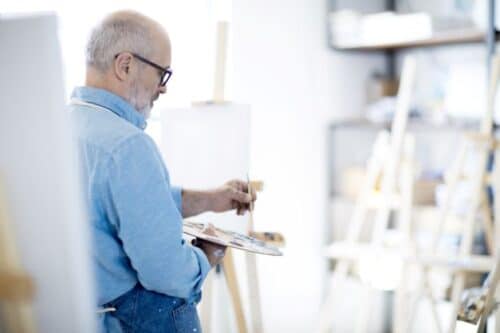Aging in Place: Nature has the Answers

Nature is not a place to visit. It is home.
-G. Snyder
Aging in Place
Recently I talked about a concept called “biomimicry” here is a brief description:
Biomimicry is the design of products and systems inspired by nature’s solutions. By emulating natural patterns and strategies, innovators create sustainable and efficient technologies. Examples include shark skin-inspired antibacterial surfaces and buildings that mimic termite mounds for temperature regulation.
The late famed futurist, Buckminster Fuller was a pioneer in employing this idea. Born nearly blind, he struggled with seeing the world around him. “Bucky” as a child was particularly interested in nature and viewed it through the thick lens of a Magnifying Glass.
This obstacle ended up being his superpower, because he discovered the universe was based on 3s according to nature. Fuller then went on to use “Biomimicry” to create theories and built environments serving humanity to this day.
The Lesson
From author Ryan Holiday translating the Stoics, it has been purposed that the obstacle is the way. Bucky Fuller certainly is an extraordinary example of the theory in practice.
Next time you encounter an “obstacle” consider that it might just be the way to the solution as well.
————————————————————————————————————————————————————
Buckminster “Bucky” Fuller (1895-1983) was an American architect, systems theorist, author, designer, and inventor known for his comprehensive perspective on the world’s problems. Fuller sought to develop solutions that required minimal resources and had maximum positive impact on humanity.
Key Accomplishments:
- Geodesic Dome: Fuller popularized the geodesic dome, a lightweight, cost-effective, and structurally sound architectural form. These domes are used worldwide in various applications due to their efficiency and strength.
- Dymaxion House: An innovative and prefabricated house designed to be mass-produced, energy-efficient, and affordable. The Dymaxion House incorporated sustainable features and aimed to solve housing shortages.
- Dymaxion Car: A highly aerodynamic, three-wheeled vehicle designed for efficiency and maneuverability. Although it never went into mass production, it showcased Fuller’s forward-thinking approach to transportation.
- Dymaxion Map: A world map projection that displays the Earth’s continents without the distortions inherent in other map projections, aiming to present a more accurate representation of the planet.
- Operating Manual for Spaceship Earth: A book in which Fuller presents the idea of Earth as a spaceship with limited resources, advocating for sustainable living and efficient use of resources.
- World Game: A simulation game designed by Fuller to solve global problems by encouraging participants to find ways to achieve the highest quality of life for all people without disadvantaging anyone.
- Synergetics: Fuller’s exploration of geometric structures and their applications to understanding complex systems and sustainability, detailed in his books “Synergetics: Explorations in the Geometry of Thinking.”
Fuller’s work spans numerous disciplines, and his ideas continue to influence architecture, design, environmentalism, and futurism.
